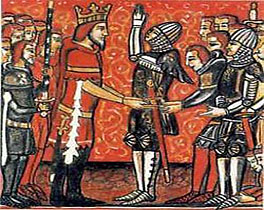 This post is intended to provide only a brief and basic overview of feudalism, not an in-depth study by any means. The idea is to hopefully stimulate discussion about feudalism from more knowledeable experts than myself.
This post is intended to provide only a brief and basic overview of feudalism, not an in-depth study by any means. The idea is to hopefully stimulate discussion about feudalism from more knowledeable experts than myself.
The word “feudalism” is a 17th century term used by legal historians to explain the political and social aspects of medieval society. It’s a term most often applied to the society of medieval Western Europe between the 10th and 13th centuries — though the basis of feudalism existed well before this period and even extended beyond the late Middle Ages. The foundation of feudalism (this term being derived from “fief”) lies in the personal relationship between a king or lord and his vassals. A lord provided his vassal with land and rights to the land and its revenues, and in turn, the vassal provided the lord military service and counsel, among other things. These sets of mutual obligations between lord and vassal shaped the political and social organizations of the upper class, who depended heavily on both the Church and the lower classes (villeins, peasants, serfs) to support them: the Church, politically, and the peasants, economically.
One of the factors that contributed to the rise of feudalism was the dissolution and weakening of strong, centralized states and public authorities. State authorities were no longer able to exercise their administrative and military control as effectively, and as such, power shifted to individuals and aristocratic families, who formed tight, personal bonds with one another. This shift in climate produced competition among rival lords, and as these lords acquired more land and gained more support, they also gained more autonomy and more power.
During the 14th century, kings and lords still exploited the feudal system for their own personal gain and authority, but by the later Middle Ages, a new state structure began to emerge. Certainly by the 15th century, feudalism no longer played as dominant a role in the military, as monarchs built their armies around mercenary soldiers — though this practice of paying soldiers did exist during earlier centuries of the medieval period (e.g. – the French employed Genoese crossbowman at the Battle of Crecy, 1346). While the feudal system of medieval western Europe began to decline in the late Middle Ages, feudalism still created a framework for the resurgance of the idea of the state and played an important and conceptual role in government for the centuries that followed.
Source:
English, Edward D. “feudalism.” Encyclopedia of the Medieval World, vol. 1. New York: Facts On File, Inc., 2005. Ancient and Medieval History Online. Facts On File, Inc. http://www.fofweb.com/activelink2.asp?ItemID=WE49iPin=EMW0511&SingleRecord=True (accessed November 18, 2008).
*image is in the public domain; Roland pledges fealty to Charlemagne, from the manuscript of a “chanson de geste”
Additional Reading:
David Herlihy, ed., The History of Feudalism (New York: Harper & Row, 1970); Elizabeth A. R. Brown, “The Tyranny of a Concept: Feudalism and Historians of Medieval Europe.” The American Historical Review 79 (1974): 1063–1088; Marc Bloch, Feudal Society, 2 vols. (Chicago: University of Chicago Press, 1961); Jean-Pierre Poly and Eric Bournazel, The Feudal Transformation, 900–1200, trans. Caroline Higgitt (New York: Holmes & Meier, 1991); Susan Reynolds, Feifs and Vassals: The Medieval Evidence Reinterpreted (Oxford: Oxford University Press, 1994).
*Wikipedia also has a good entry on feudalism with a list of additional reading references.